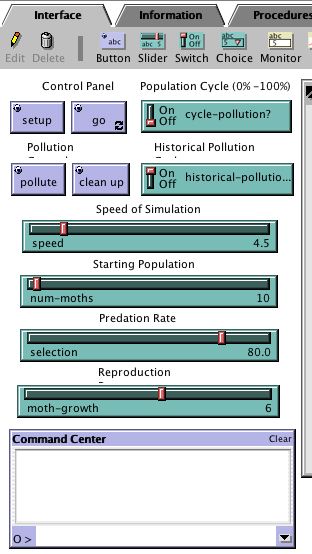|
a collaboration of the
Shodor Education Foundation, Inc.
, Eastern North Carolina School for the Deaf,
Barton College
, the
National Technical Institute for the Deaf
, and
Interpreters, Inc.
|
|
|
Home
|
For Interpreters!
|
Search
|
Peppered Moths
Agents
The Stella model gave good results that matched the field observations. As scientists we need to ask if these results are a coincidence. Does the model accurately and appropriately represent the process happening in the field? When scientists collected data in the field they didn't know the total number of moths in the area. The scientists assumed that the moths they collected represented the total population i.e. the frequencies were the same. | |
All models make assumptions. One of the big assumptions made by this model is that the interactions of the birds and moths can be represented statistically. For example, the model treats all of the AA moths as one group. A fraction of the AA group dies or reproduces. In the field the moths don't act as a group. They don't move in formation like an army. The moths act as individuals. The moths move in random directions and have chance meetings with birds or other moths. Can a model that represents the moths as groups accurately reflect the interactions of individual agents? | |
Stella is designed to model group behavior. It is difficult to model the interaction of individual agents using Stella. Net Logo models individual agents that interact with each other. | |
Ask your teacher for the Net Logo model "PepperedMoths" Open the model and select the interface tab. You see a group of sliders and controls at the left, a field with moths in the center and a blank graph at the right. | |
The two top green controls set the pollution. Turning "cycle-pollution?" on makes the pollution level to rise and fall over and over again. Turning "historical-pollution" on simulates historical pollution levels. | |
The green slider "Speed of Simulation" controls how fast the pollution levels change. If you are in a hurry move the slider to the right and the pollution will cycle in a few years. Move the slider to the left and you will see a more natural, gradual cycling of the pollution level. | |
The interaction rates, for individual moths, isn't known. You can adjust the sliders "Starting Population", "Predation Rate", and "Reproduction" to levels that you find appropriate. | |
After you have adjusted the controls to the levels you want, click on the "setup" button. This tells the model to generate random moths that match your parameters. Clicking the "go" button starts the simulation. | |
As the model runs, the moths act as individual agents. Individual moths die of natural causes, and predation by birds. If two moths of opposite sex come together, they can mate and produce eggs. These eggs carry the genetic material of their parents. The adult moths die and the eggs form the next generation. | |
Run the model. | |
Do the results of your simulations support the theory of natural selection? Explain your answer. | |
| <<< Back | |
|---|---|

Developed by
The Shodor Education Foundation, Inc.
Copyright © 2002 by The Shodor Education Foundation, Inc
This project is supported, in part, by the National Science Foundation
Opinions expressed are those of the authors and not necessarily
those of the National Science Foundation.


